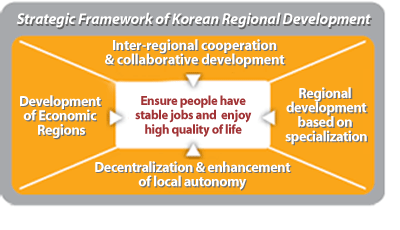- Creation of Competitive Regions Ensuring Employment and Quality of Life
- Establishment of Economic Regions
- Specialized Regional Development
- Regional Devolution & Autonomy
- Inter-regional Cooperation & Co-prosperity
- To maximize growth potential for the entire nation
- To discover new growth engines & promote specialized regional development
- To strengthen decentralization through delegation of power from central to local governments
- To support co-prosperity among Capital and non-Capital regions
- To further develop and complement existing policies for regional development
- To revamp the institutional system including Special Act on Balanced National Development and balanced development special accounts
A New policy paradigm in the era of global competition
Every country in the world is engaged in global competition. More so than focusing on alleviation of regional disparities, strengthening regional competitiveness is vital for national competitiveness. Correspondingly, rather than aiming towards balanced regional development, we should cultivate each region's individual growth potential as much as possible.
Regional competitiveness is vital to compete in the world. In addition to current administrative boundaries, it is necessary to establish specialized and enlarged economic regions. We need to enhance regional competitiveness by utilizing economies of scale and regional specialization so that our economic regions can compete with other powerful regions around the world.
We intend to achieve co-prosperity among regions. In Korea, forty-nine percent of the total population and fifty-three percent of total economic activities are concentrated in the Capital Region. Our policy goal should not be to reach a blind equality. This is the source of more serious regional conflicts, and as such, we must try to minimize trade-offs between regions.
Four key strategies of the new regional development policy
First of all, the new policy framework is centered around a three-tiered approach made along different geographical scales:
- the Economic Region strategy is to regroup upper-tier local governments (7 metropolises and 9 provinces) into 7 Economic Regions;
- the Local Area strategy is to provide quality of life services and income-earning opportunities for all the residents in lower-tier local governments in 163 cities and counties;
- the Supra-economic Region strategy is to create four Supra-economic Regions along the coastlines or the national border, with additional three Inland Supra-economic Regions for the promotion of collaboration among economic regions as well as cross-border cooperation.
Secondly, the government plans to nurture new regional growth engines and promote regional development based on specialization. Accordingly, selected strategic industries will be fostered for each economic region to improve global competitiveness.

Thirdly, in order to enforce decentralization through delegation of power from the central government to local governments, the following tasks are to be carried out: devolution of central government's responsibilities to local government units; tax redistribution between central and local governments; integration of myriads of national subsidies into block grants for regional development; and transfer of development authority to local governments for better performance of planning and implementation.
Fourth, the symbiotic development of the Capital Region and non-Capital regions can be pursued through diverse channels. They include a step-wise deregulation of the Capital Region made concurrently with regional development in non-Capital regions, and the transfer of capital gains earned by developing land in the Capital Region to local governments in non-Capital regions.
Regional development policy is nation-wide, inter-ministerial and all-encompassing in itself. PCRD is a unique agency which is in charge of coordination and orchestration of the regional development policy of Korea.
A region is a highly comprehensive mixture of land, nature, people, culture and economy. Regional development policy must take these factors into account. An agency whose mission is specialized in a specific sector cannot cope with all the regional issues which may arise. Hence, the Korean government established an agency through which all policies and administrative measures for regional development could be coordinated and synthesized.
PCRD is orchestrating regional policies of government agencies such as the Ministry of Knowledge Economy; the Ministry of Strategy and Finance; the Ministry of Education, Science and Technology; the Ministry of Public Administration and Security; the Ministry of Culture, Sports and Tourism; the Ministry for Food, Agriculture, Forestry and Fisheries; the Ministry of Health and Welfare; the Ministry of Environment; and the Ministry of Land, Transport and Maritime Affairs. In addition, PCRD members include prominent experts and scholars. Chairman Sangchuel Choe (Professor Emeritus of Seoul National University) has successfully led PCRD since May 2008.
In August 2009, seven Economic Region Development Committees (Capital, Chungcheong, Honam, Daegyeong, Dongnam, Gangwon and Jeju Region) were established to deal with each Economic Region’s development issues. In accordance and cooperation with PCRD, those ERDCs are expected to drive towards more systematic and locality-sensitive regional development policies.











![[프로그램입력]](../../images/nav/nav_off_01.gif)
![[프로그램입력]](../../images/nav/nav_off_02.gif)
![[프로그램입력]](../../images/nav/nav_off_03.gif)
![[프로그램입력]](../../images/nav/nav_off_04.gif)
![[프로그램입력]](../../images/nav/nav_off_05.gif)









